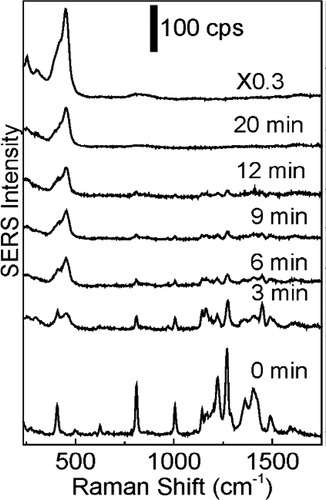当前位置:
X-MOL 学术
›
J. Phys. Chem. C
›
论文详情
Our official English website, www.x-mol.net, welcomes your feedback! (Note: you will need to create a separate account there.)
NaHS Induces Complete Nondestructive Ligand Displacement from Aggregated Gold Nanoparticles
The Journal of Physical Chemistry C ( IF 3.7 ) Pub Date : 2018-01-17 00:00:00 , DOI: 10.1021/acs.jpcc.7b10069 Sumudu Athukorale 1 , Maleesha De Silva 1 , Allen LaCour 1 , Ganganath S. Perera 1 , Charles U. Pittman 1 , Dongmao Zhang 1, 2
The Journal of Physical Chemistry C ( IF 3.7 ) Pub Date : 2018-01-17 00:00:00 , DOI: 10.1021/acs.jpcc.7b10069 Sumudu Athukorale 1 , Maleesha De Silva 1 , Allen LaCour 1 , Ganganath S. Perera 1 , Charles U. Pittman 1 , Dongmao Zhang 1, 2
Affiliation

|
Ligand displacement from gold is important for a series of gold nanoparticle (AuNP) applications. Complete nondestructive removal of organothiols from aggregated AuNPs is challenging due to the strong Au–S binding, the steric hindrance imposed by ligand overlayer on AuNPs, and the narrow junctions between the neighboring AuNPs. Presented herein is finding that monohydrogen sulfide (HS–), an anionic thiol, induces complete and nondestructive removal of ligands from aggregated AuNPs. The model ligands include aliphatic (ethanethiol(ET)) and aromatic monothiols, methylbenzenethiol (MBT), organodithiol (benzenedithiol (BDT)), thioamides (mercaptobenzimidazole (MBI) and thioguanine (TG)), and nonspecific ligand adenine. The threshold HS– concentration to induce complete ligand displacement varies from 105 μM for MBI and TG to 60 mM for BDT. Unlike using HS–, complete ligand displacement does not occur when mercaptoethanol, the smallest water-soluble organothiol, is used as the incoming ligand. Mechanistically, HS– binding leads to the formation of sulfur monolayer on AuNPs that is characterized with S–S bonds and S–Au bonds, but with no detectable S–H spectral features. The empirical HS– saturation packing density and Langmuir binding constant on AuNPs are 960 ± 60 pmol/cm2 and (5.5 ± 0.8) × 106 M–1, respectively. The successful identification of an effective ligand capable of inducing complete and nondestructive removal of ligands from AuNPs should pave the way for using AuNP for capture-and-release enrichment of biomolecules that have high affinity to AuNP surfaces.
中文翻译:

NaHS从聚集的金纳米颗粒诱导完全无损的配体置换。
金的配体置换对于一系列金纳米粒子(AuNP)应用很重要。由于强的Au-S结合,配体层对AuNPs施加的空间位阻以及相邻AuNPs之间的狭窄连接,从聚集的AuNPs中完全无损地去除有机硫醇具有挑战性。本文提出的发现是,硫化氢(HS –),一种阴离子硫醇,可诱导从聚集的AuNP中完全无损地去除配体。模型配体包括脂肪族(乙硫醇(ET))和芳香族单硫醇,甲基苯硫醇(MBT),有机二硫醇(苯二硫醇(BDT)),硫代酰胺(巯基苯并咪唑(MBI)和硫代鸟嘌呤(TG))和非特异性配体腺嘌呤。阈值HS –诱导配体完全置换的浓度范围从MBI和TG的105μM到BDT的60 mM不等。与使用HS –不同,当巯基乙醇(最小的水溶性有机硫醇)用作引入的配体时,不会完全取代配体。机械地,HS -结合导致硫单层上的AuNP的形成,其特征在于用S-S键和S-金键,但是没有检测到S-H的光谱特征。经验HS –饱和堆积密度和Langmuir在AuNP上的结合常数为960±60 pmol / cm 2和(5.5±0.8)×10 6 M –1, 分别。成功鉴定出能够诱导从AuNPs完全无损去除配体的有效配体,应为使用AuNP进行捕获和释放富集对AuNP表面具有高度亲和力的生物分子铺平道路。
更新日期:2018-01-17
中文翻译:

NaHS从聚集的金纳米颗粒诱导完全无损的配体置换。
金的配体置换对于一系列金纳米粒子(AuNP)应用很重要。由于强的Au-S结合,配体层对AuNPs施加的空间位阻以及相邻AuNPs之间的狭窄连接,从聚集的AuNPs中完全无损地去除有机硫醇具有挑战性。本文提出的发现是,硫化氢(HS –),一种阴离子硫醇,可诱导从聚集的AuNP中完全无损地去除配体。模型配体包括脂肪族(乙硫醇(ET))和芳香族单硫醇,甲基苯硫醇(MBT),有机二硫醇(苯二硫醇(BDT)),硫代酰胺(巯基苯并咪唑(MBI)和硫代鸟嘌呤(TG))和非特异性配体腺嘌呤。阈值HS –诱导配体完全置换的浓度范围从MBI和TG的105μM到BDT的60 mM不等。与使用HS –不同,当巯基乙醇(最小的水溶性有机硫醇)用作引入的配体时,不会完全取代配体。机械地,HS -结合导致硫单层上的AuNP的形成,其特征在于用S-S键和S-金键,但是没有检测到S-H的光谱特征。经验HS –饱和堆积密度和Langmuir在AuNP上的结合常数为960±60 pmol / cm 2和(5.5±0.8)×10 6 M –1, 分别。成功鉴定出能够诱导从AuNPs完全无损去除配体的有效配体,应为使用AuNP进行捕获和释放富集对AuNP表面具有高度亲和力的生物分子铺平道路。



























 京公网安备 11010802027423号
京公网安备 11010802027423号